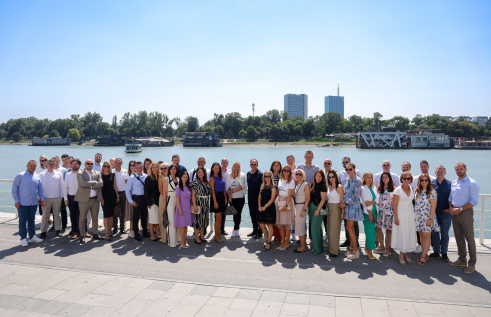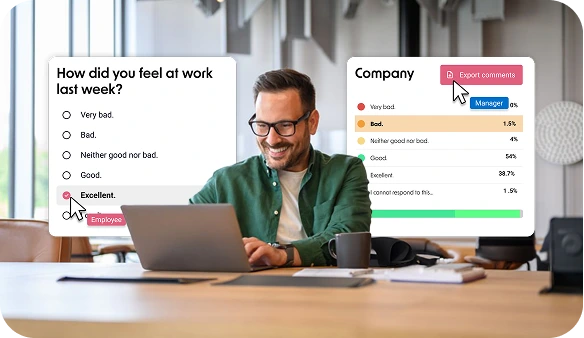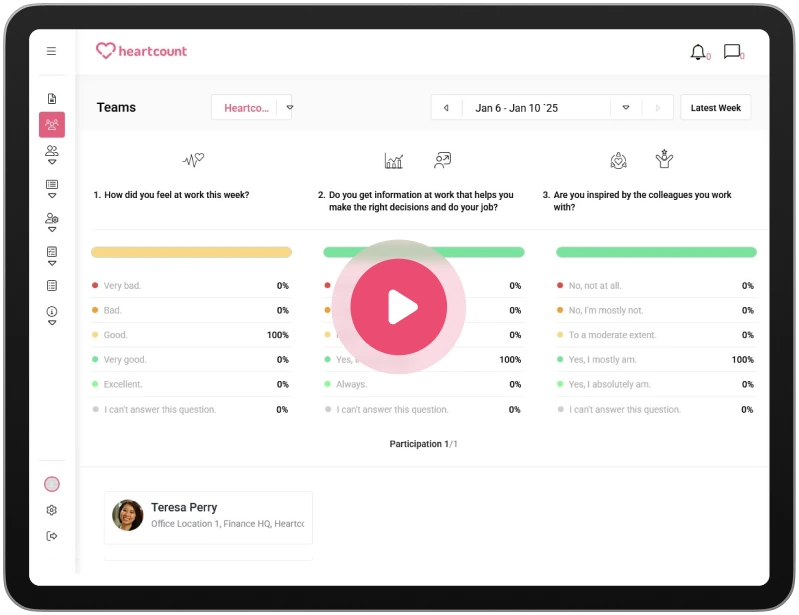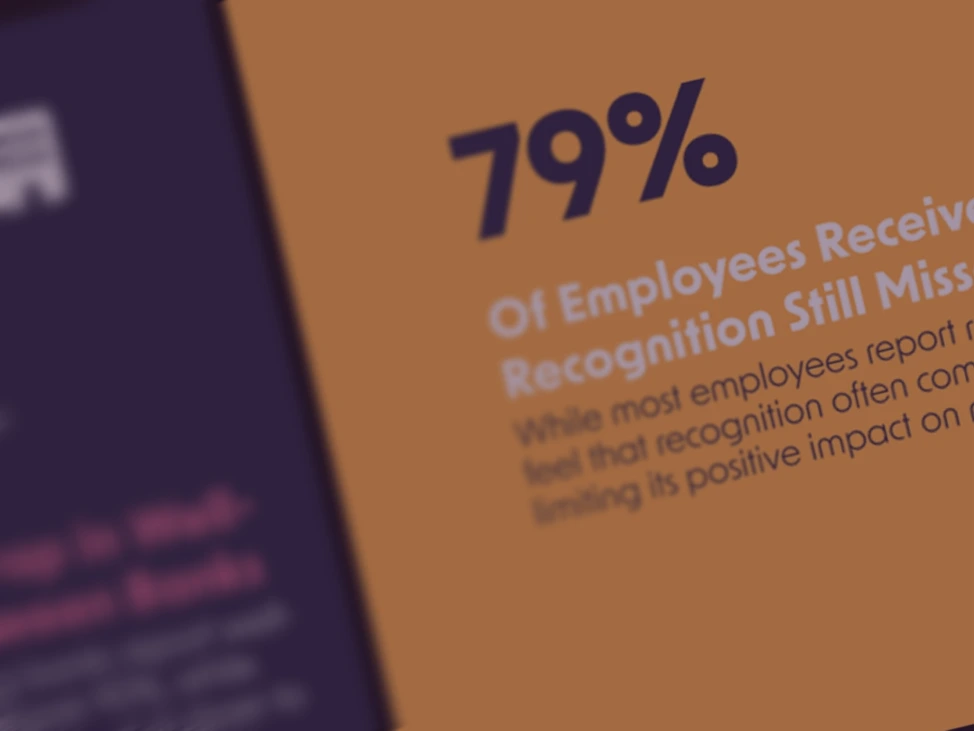Employee Journey Mapping: Stages, Touchpoints & Template for 2025

Employee expectations have evolved rapidly over the past few years. Hybrid work, the rise of purpose-driven careers, and a renewed focus on well-being have all reshaped what people look for in their professional lives. Today, organisations need more than great policies—they need a clear, structured view of the employee journey to design experiences that attract, engage, and retain top talent.
An employee journey map helps you visualise every stage and touchpoint that shapes perception, from the moment someone first discovers your brand to their last day—and often beyond. By proactively designing these experiences, you can reduce turnover, improve engagement, and create a culture where people thrive.
At HeartCount, we’ve seen firsthand how mapping the journey and pairing it with real-time feedback can transform employee satisfaction and performance. In fact, according to Gallup research, organisations with a strong focus on employee experience report 23% higher profitability than their peers—underscoring the power of intentional design.
In this guide, we’ll explore:
- What the employee journey really is (and isn’t)
- The six core stages and key touchpoints
- A step-by-step process for creating your own journey map
- Best practices to avoid common pitfalls
- A ready-to-use template for 2025
-
1.What Is the Employee Journey?
-
2.Why Employee Journey Mapping Matters
-
3.The 6 Core Stages and Touchpoints of the Employee Journey
-
4.How to Create an Employee Journey Map in 7 Steps
-
5.Employee Journey Map Template
-
6.Employee Journey Mapping Best Practices
-
7.From Map to Continuous Improvement
-
8.FAQ: Employee Journey & Mapping
Employee expectations have evolved rapidly over the past few years. Hybrid work, the rise of purpose-driven careers, and a renewed focus on well-being have all reshaped what people look for in their professional lives. Today, organisations need more than great policies—they need a clear, structured view of the employee journey to design experiences that attract, engage, and retain top talent.
An employee journey map helps you visualise every stage and touchpoint that shapes perception, from the moment someone first discovers your brand to their last day—and often beyond. By proactively designing these experiences, you can reduce turnover, improve engagement, and create a culture where people thrive.
At HeartCount, we’ve seen firsthand how mapping the journey and pairing it with real-time feedback can transform employee satisfaction and performance. In fact, according to Gallup research, organisations with a strong focus on employee experience report 23% higher profitability than their peers—underscoring the power of intentional design.
In this guide, we’ll explore:
- What the employee journey really is (and isn’t)
- The six core stages and key touchpoints
- A step-by-step process for creating your own journey map
- Best practices to avoid common pitfalls
- A ready-to-use template for 2025
What Is the Employee Journey?
The employee journey is the complete series of experiences an individual has with your organisation, from the moment they first discover your brand to their final day—and often beyond. It is more than a sequence of HR processes; it is the cumulative perception employees form at every touchpoint, shaping their engagement, performance, and loyalty.
By understanding and mapping this journey, companies can proactively design experiences that meet both business objectives and employees’ evolving expectations. Especially in 2025, where hybrid work, flexibility, and purpose are driving career decisions, having a clear view of the journey has become essential.
Employee Journey vs. Employee Experience vs. Customer Journey
These terms are often used interchangeably but have distinct meanings:
- Employee Journey is the timeline of stages and interactions employees move through during their tenure. It’s a process-based view, mapping how they progress from candidate to alumni.
- Employee Experience is the sum of perceptions and feelings employees have about all aspects of their work. It is more subjective and emotional, covering culture, technology, management, and environment.
- Customer Journey applies similar mapping principles to the customer lifecycle, focusing on purchasing decisions and brand loyalty. While customer journey mapping inspired many HR practices, employee journeys require different priorities—like development, recognition, and well-being.
When you map the employee journey, you gain a framework for measuring and improving experience at each stage.
Key Terms: Journey Map, Touchpoints, Moments That Matter
To build clarity and shared language across HR, here are some important definitions:
- Employee Journey Map: A visual representation of the end-to-end stages, milestones, and touchpoints employees encounter. It typically shows phases, objectives, pain points, and opportunities for improvement.
- Touchpoints: Any interaction or event between the employee and the organisation, from the first job ad they see to exit interviews and alumni check-ins. These include formal processes (e.g., onboarding sessions) and informal moments (e.g., receiving peer recognition).
- Moments That Matter: Critical touchpoints that have a disproportionate impact on engagement and perception. For example, the first day, performance reviews, promotions, and personal milestones are often decisive experiences that shape how employees feel about their employer.
Why Employee Journey Mapping Matters
Mapping the employee journey is not just a design exercise—it’s a strategic lever for improving performance, retention, and culture. When organisations understand the real experience of their people, they can prioritise improvements that drive measurable ROI.
According to McKinsey, organisations with strong employee experience strategies are twice as likely to outperform peers in profitability. Structured journey mapping is a critical first step in aligning touchpoints to those outcomes.
Retention & Engagement ROI (Data Snapshot)
Turnover remains one of the most costly challenges in the workplace. Research by Gallup shows that voluntary turnover costs U.S. businesses over $1 trillion each year, driven by factors like ineffective onboarding, lack of development, and unaddressed frustrations.
When you map the employee journey, you create a foundation to:
- Reduce early attrition by refining key onboarding moments
- Improve engagement by focusing on critical “moments that matter”
- Boost productivity through clearer expectations and aligned culture
Companies that combine journey mapping with continuous listening see even greater benefits. For example, using automated employee pulse check surveys makes it easier to capture employee sentiment in real time, so teams can respond to issues before they escalate.
Pinpointing Pain-Points with HeartCount Pulse Data
Journey mapping is most effective when paired with real-time feedback. While traditional surveys capture snapshots in time, weekly pulse surveys enable HR and managers to see where frustration, confusion, or disengagement emerge along the journey.
With tools like HeartCount’s Employee Experience Management Software, teams can:
- Track sentiment at each stage (e.g., onboarding, performance reviews)
- Correlate touchpoints with engagement and satisfaction trends
- Identify gaps between intended processes and actual perceptions
This data-driven approach transforms journey mapping from a static diagram into an actionable improvement system.
It’s not enough to collect data—you need a plan to act on it. Leading organisations adopt a listen → diagnose → act cycle to ensure feedback translates into real change:
- Listen: Gather insights through surveys, interviews, and observations.
- Diagnose: Analyse the data to pinpoint priority areas.
- Act: Implement improvements, then measure progress over time.
A Deloitte study in healthcare shows that while only 54% of clinicians felt organisations actually acted on feedback, a mere 8% said this happened regularly—highlighting a serious gap in closing the loop. We see similar challenges across industries: listening without follow-through erodes trust and stalls engagement.
That’s why at HeartCount, we emphasise assigning clear ownership, timelines, and success metrics to each improvement initiative—so that feedback truly leads to better experiences and outcomes.
The 6 Core Stages and Touchpoints of the Employee Journey
Every employee journey is unique, but most follow a similar progression of stages. Mapping these stages in detail helps you understand what people need at each point—and where small improvements can make a big difference in engagement and retention.
Below is an overview of the six core stages and the most common touchpoints within each.
Stage-by-Stage Table
| Stage | Key Touchpoints |
| Attract & Recruit | Job ads, career site, application process, interviews, offer letters |
| Onboard & Ramp-Up | Welcome messages, orientation sessions, first-week check-ins, training milestones |
| Engage & Connect | Manager 1:1s, team meetings, employee resource groups, recognition moments |
| Develop & Grow | Career conversations, development plans, learning programs, stretch assignments |
| Recognize & Retain | Performance reviews, promotions, rewards programs, employee recognition ceremonies |
| Transition or Exit | Stay interviews, offboarding meetings, exit surveys, alumni outreach |
Attract & Recruit
The journey begins long before a signed contract. Candidates form impressions through job postings, your website, and the responsiveness of your hiring process. Clear communication, prompt feedback, and transparency set the tone for trust.
Onboard & Ramp-Up
The first weeks are critical for building confidence and connection. Effective onboarding blends structured training with personal welcomes, manager support, and frequent check-ins. According to SHRM, great onboarding can improve retention by over 80%.
Engage & Connect
Once employees settle in, they need opportunities to build relationships and feel part of something bigger. Regular 1:1s, clear goals, peer support, and inclusive team rituals all contribute to a sense of belonging. This is also the stage where recognition plays a vital role—using tools like employee recognition can help keep appreciation consistent and visible.
Develop & Grow
Employees expect growth, not just tasks. Development conversations, upskilling, mentorship, and clear career paths are key touchpoints here. Mapping this stage helps you identify where people feel stuck or unsupported. To make these insights actionable, many teams rely on tools like workplace transparency practices and structured career frameworks to ensure expectations and opportunities are clearly communicated.
Recognize & Retain
This phase is about sustaining motivation. Milestone celebrations, rewards, and transparent performance evaluations are crucial. When employees feel seen and valued, they are much more likely to stay long-term. Resources like employee satisfaction surveys can help you measure whether recognition efforts are effective.
Transition or Exit
Even as employees prepare to leave, their experiences matter. A smooth offboarding process, candid exit surveys, and alumni outreach protect your reputation and can lead to future boomerang hires. HeartCount makes it easy to collect and track insights throughout this final stage with tools like the employees overview dashboard, which keeps visibility on the entire journey from hire to exit.
When you visualise these stages as part of a single employee journey map, you gain a clearer picture of where to focus improvements and how to measure progress.
How to Create an Employee Journey Map in 7 Steps
Building an employee journey map doesn’t have to be overwhelming. By following a structured process, you can move from scattered observations to a clear, actionable blueprint. Here are seven steps to guide you through creating a journey map that drives meaningful improvements:
1. Define Goals & Success Metrics
Start by clarifying why you are mapping the journey. Are you aiming to reduce turnover, improve engagement, or streamline onboarding? Clear goals help you prioritise which touchpoints and stages to focus on and define how you’ll measure success.
2. Identify Employee Personas
Not all employees experience the journey the same way. Segment your workforce into personas based on factors like role, tenure, location, or generation. For example, a new graduate’s needs will differ from those of a senior manager. Personas help you understand and design for different expectations and pain points.
3. List Journey Stages & Touchpoints
Map out the six core stages—Attract & Recruit, Onboard & Ramp-Up, Engage & Connect, Develop & Grow, Recognize & Retain, and Transition or Exit—and the touchpoints within each. You can use surveys, focus groups, or interviews to validate whether your assumptions match real experiences.
4. Gather Data & Feedback (Pulse Surveys, Interviews)
Rich data makes your journey map credible and actionable. Combining quantitative sources (like engagement surveys) with qualitative feedback (like interviews) gives you a fuller picture of how employees perceive each moment. For deeper insights, explore our guide on how to drive employee engagement.
5. Visualise with a Journey Map Template
Create a visual representation of the stages, touchpoints, employee emotions, and improvement opportunities. You don’t need sophisticated software—a simple table, flowchart, or slide deck can work. What matters is making it accessible and clear.
6. Prioritise Moments That Matter & Quick Wins
Identify which touchpoints have the biggest impact on engagement and retention. These “moments that matter” are often where you can see quick wins by removing friction or adding positive reinforcement. If you’re unsure where to start, consider focusing on moments linked to feedback and recognition, which have a strong connection to retention and well-being. You can read more about this in how to give feedback to employees.
7. Act, Measure, and Iterate Quarterly
A journey map isn’t a static document. Assign owners for each improvement initiative, set timelines, and review progress quarterly. Over time, you can evolve the map as your culture and workforce change.
Employee Journey Map Template
A clear, structured template makes it much easier to visualise the employee journey and share insights across your organisation. While your exact format may vary, most effective templates include these core components:
1. Stages: The phases employees move through, from attraction to exit. For consistency, consider using the six stages outlined earlier.
2. Touchpoints: Specific interactions employees have during each stage, such as interviews, onboarding meetings, performance reviews, and offboarding conversations.
3. Employee Emotions and Needs: Capture how employees typically feel at each touchpoint (e.g., excited, uncertain, disengaged) and what they need to be successful.
4. Pain Points and Opportunities: Identify friction areas and ideas for improvement. For example, unclear expectations during onboarding or lack of career conversations in the development phase.
5. Owners and Actions: Assign clear responsibility for each stage and define actions and timelines to improve the experience.
Below is a sample table-style template you can adapt to your organisation:
| Stage | Key Touchpoints | Employee Emotions | Pain Points | Improvement Actions | Owner |
| Attract & Recruit | Job ads, interviews, offer letters | Curious, hopeful | Slow feedback, unclear timelines | Streamline communication process | Talent Acquisition Lead |
| Onboard & Ramp-Up | Orientation, first-week check-ins | Excited, overwhelmed | Too much information at once | Stagger onboarding materials | HR Manager |
| Engage & Connect | Team meetings, 1:1s, recognition moments | Connected, motivated | Inconsistent feedback | Standardise regular check-ins | Department Heads |
| Develop & Grow | Training, career conversations | Ambitious, uncertain | Lack of clear growth paths | Launch development planning toolkit | L&D Lead |
| Recognize & Retain | Reviews, promotions, rewards | Valued, secure | Recognition feels arbitrary | Create transparent criteria | HR Director |
| Transition or Exit | Exit interviews, alumni outreach | Reflective, appreciative | Limited alumni engagement | Launch alumni network | HR Business Partner |
You can adapt this framework to a visual timeline or flowchart if you prefer a more graphical approach. The goal is to make it easy for leaders and teams to see where improvements are needed—and track accountability.
Employee Journey Mapping Best Practices
Even with the right framework, many organisations struggle to turn a journey map into measurable improvements. These best practices can help you avoid common pitfalls and create an approach that delivers real impact:
Segment by Persona & Tenure
Not every employee will experience the journey the same way. Segmenting your map by employee persona—like new graduates, mid-career professionals, or people managers—can reveal unique needs and expectations. Tenure also shapes perceptions: an employee in their first 90 days may prioritise onboarding clarity, while someone at the five-year mark is more focused on development and recognition.
Layer Real-Time Sentiment Metrics on Each Touchpoint
Static journey maps quickly become outdated. The most effective organisations layer real-time sentiment metrics over each touchpoint to understand how perceptions evolve. For example, combining exit survey themes with engagement trends can uncover patterns you might otherwise miss. This continuous listening approach is critical for maintaining momentum. If you’d like to learn more about early warning signs, explore our guide to employee burnout causes and cures.
According to Gallup research, only 31% of employees in the U.S. report feeling engaged at work—highlighting the importance of maintaining an up-to-date understanding of how experiences are landing.
Avoid Over-Engineering: Start Small, Scale Fast
It’s easy to overcomplicate your mapping project by trying to document every single touchpoint and scenario at once. Instead, start by focusing on one or two high-impact stages (like onboarding or development), validate your insights with employees, and scale from there. This helps you build credibility and show quick wins before tackling more complex areas.
Common Mistakes to Avoid
Even the most well-intentioned journey mapping initiatives can go off track. Some of the most common pitfalls include:
- Treating the map as a one-time exercise rather than an evolving tool
- Failing to assign clear ownership and follow-through for improvements
- Overlooking the connection between employee experience and retention outcomes
- Gathering feedback without closing the loop or communicating changes back to employees
For practical ideas on sustaining engagement beyond mapping, you might also explore our article on employee engagement and retention.
From Map to Continuous Improvement
An employee journey map is only valuable if it leads to action. To make sure your efforts drive real change, you’ll need to embed journey mapping into your ongoing employee experience strategy. This is where continuous improvement becomes essential.
HeartCount Listen → Diagnose → Act Cycle
At HeartCount, we recommend using a Listen → Diagnose → Act approach to keep your map alive:
- Listen: Use continuous feedback channels like weekly pulses, engagement surveys, and open-ended comments to stay connected to how employees feel at every stage.
- Diagnose: Analyse the data to identify patterns and prioritise areas that need attention.
- Act: Develop targeted initiatives, communicate changes, and measure whether improvements are working.
This cycle helps you avoid the common pitfall of creating a beautiful journey map that sits unused in a slide deck.
Assign Owners & Deadlines for Each Journey Moment
A journey map without clear accountability won’t lead to results. For each high-priority touchpoint, assign a specific owner—someone who will be responsible for driving improvements and reporting on progress. Define clear timelines and success criteria to create urgency and clarity.
For example, you might set a goal to improve the onboarding Net Promoter Score by 15% within six months, with ownership assigned to the HR onboarding lead.
Use Weekly Pulse Signals to Track Progress
Your journey map should evolve alongside your culture. Weekly pulses and real-time feedback make it possible to see whether changes are resonating—or whether you need to adjust course. Over time, this creates a culture where employees feel heard and valued.
FAQ: Employee Journey & Mapping
What is an employee journey map?
An employee journey map is a visual framework that outlines the stages and touchpoints employees experience during their time with your organisation—from recruitment to exit. It helps you see where expectations, perceptions, and needs align or diverge, so you can make improvements that drive engagement and retention.
How do you map an employee journey?
Start by defining clear goals and success metrics. Then identify key stages and touchpoints, gather feedback through surveys and interviews, and document employee emotions and pain points. Use this information to create a visual map that you can update over time. For a step-by-step approach, refer to the 7 Steps to Create an Employee Journey Map section above.
What are common employee journey touchpoints?
Typical touchpoints include job ads, interviews, onboarding sessions, team meetings, performance reviews, training programs, promotions, recognition moments, exit interviews, and alumni outreach. Every interaction—large or small—shapes the overall journey.
Is there a template for employee journey mapping?
Yes. In this guide, we’ve shared a simple table template that outlines each stage, touchpoints, employee emotions, pain points, improvement actions, and owners. You can adapt it to suit your organisation’s needs and create a more visual version if you prefer.
How often should you update the journey map?
At minimum, review your journey map annually. However, many organisations update it quarterly to keep up with changes in culture, processes, and employee expectations. Regular updates ensure it stays relevant and actionable.
Can journey mapping reduce employee attrition?
Absolutely. When you systematically improve the moments that matter—especially onboarding, development, and recognition—you can significantly increase engagement and reduce voluntary turnover. According to Gallup, organisations that prioritise employee experience outperform peers in retention and profitability.








